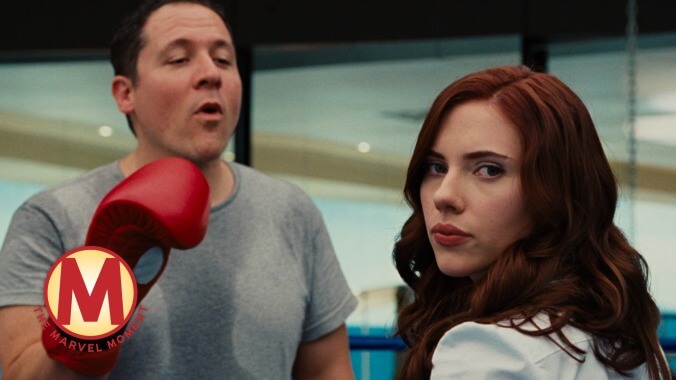Iron Man 2 made the MCU look more viable, even as it botched the introduction of a key player


“There was an idea… to bring together a group of remarkable people. To see if we could become something more. So when they needed us, we could fight the battles that they never could.”
That mission statement, heard over the Avengers: Infinity War trailer, hearkens back to 2010’s Iron Man 2, which, as our own review noted, has “at least two sequels’ worth of incident” crammed into it. Although it fails in the villain and spectacle department, Jon Favreau’s second installment in the franchise expands the Avengers initiative, both the one in story and the one gaining traction in Marvel Studios’ executive offices. Some light groundwork had been done in Jon Favreau’s Iron Man, which introduced S.H.I.E.L.D director Nick Fury (Samuel L. Jackson) and Agent Coulson (Clark Gregg). The Incredible Hulk, although poised to extend the Marvel Cinematic Universe, ended up being a non-starter; Mark Ruffalo, who replaced Edward Norton as Bruce Banner in The Avengers, has made the role his own, but the solo Hulk franchise hasn’t gone anywhere.
But just as Tony Stark (Robert Downey Jr.) popping up next to Thaddeus Ross (William Hurt) in the Hulk post-credits scene gave the cinematic universe-building some much-needed momentum, Iron Man 2 brought several future players and larger narratives of the MCU into focus. Agent Coulson remains mostly on the periphery, but that’s in part due to the hammer-related situation developing in New Mexico. It’s a smart, very economical bit of storytelling from Favreau and writer Justin Theroux—through a few one-sided phone calls, Coulson becomes a part of two franchises, and well on his way to heading up his own series.
A couple of tête-à-têtes between Fury and Tony add a few more layers to both characters—we learn Fury is as much a visionary as Tony and the latter’s father, Howard Stark, who was “about to kick off an energy race that was going to dwarf the arms race.” His self-interests are as plain as day, but Fury becomes more than a shadowy figure who occasionally negs Iron Man; he demonstrates he’s just as invested in big-picture thinking as Howard and his budding futurist son. Tony, meanwhile, is placed much more firmly in his father’s footsteps, something he’d been ambivalent about up until this point. He upgrades his power source, the arc reactor, which is first a clean-energy beacon, then a bulls-eye for alien invaders in The Avengers. The arc reactor is what brings Ivan Vanko (Mickey Rourke) into Tony’s orbit—his father Anton co-designed it with Howard Stark—and it’s also some alluring loot for The Vulture in Spider-Man: Homecoming, which also features Tony Stark and Happy Hogan (Favreau).
The world-building is purposeful, mostly subtle, and a far cry from the franchise growing pains of Avengers: Age Of Ultron. But the introduction of Natalie Rushman, a.k.a Natasha Romanoff, a.k.a. Black Widow (in all three cases, Scarlett Johansson) leaves a lot to be desired. Over the course of her 10 film appearances, we’ve come to see Black Widow as a hyper-competent and vital member of the Avengers, but Iron Man 2 focuses far too much on her femme fatale side. “Natalie” is Natasha’s Stark Industries cover, allowing her to make a detailed assessment of how Tony/Iron Man would fare in a team environment like, say, the Avengers Initiative. She provides keen and unflinching analysis of Tony’s “textbook narcissism,” and handily deals with Hammer goons before showing off some impressive hacking skills; she’s also frequently shot at an angle that’s best described as “down her blouse.” Not long after she’s literally introduced as a “potentially very expensive sexual harassment lawsuit,” we do get Natalie’s full resume, including language proficiencies, interest in world affairs, and a portfolio from her modeling days. This exploration of the full range of Natalie/Natasha’s assets is important and grounded in the source material; even the lingerie model stuff, which was likely a cover for a mission in Tokyo, helps establish how she was able to infiltrate Tony’s organization. Then this happens:
Again, Tony (and everyone else) is frequently blindsided by Natasha’s capabilities, but with those three words—“I want one”—the inconsistent and occasionally downright disappointing treatment of the character begins. When she reemerges as Agent Romanoff, she enters the frame ass-first. In the third act, she undresses in the back of Happy’s car as he gawks at her in the rearview mirror. Black Widow fares much better in later films, including two Captain America movies and The Avengers, before essentially being reduced to a love interest in Avengers: Age Of Ultron (cool motorcycle sequence aside)—clearly her solo outing has a lot of ground to recover. But though Iron Man 2 provides a wobbly platform for one future Avenger, it did make the the future of the wider MCU look a lot brighter.
GET A.V.CLUB RIGHT IN YOUR INBOX
Pop culture obsessives writing for the pop culture obsessed.